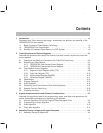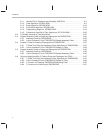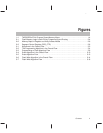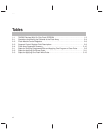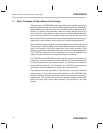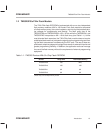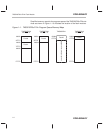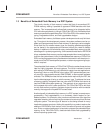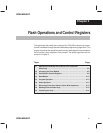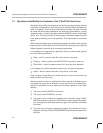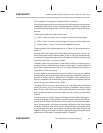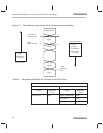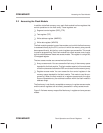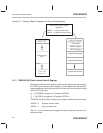
Benefits of Embedded Flash Memory in a DSP System
PRELIMINARY
1-5
Introduction
PRELIMINARY
1.3 Benefits of Embedded Flash Memory in a DSP System
The circuitry density of flash memory is about half that of conventional EE-
PROM memory, making it possible to approach DRAM densities with flash
memory. This increased density allows flash memory to be integrated with a
CPU and other peripherals in a single ’F20x/F24x DSP chip. Embedded flash
memory expands the capabilities of the ’F20x/F24x DSPs in the areas of proto-
typing, integrated solutions, and field upgradeable designs.
Embedded flash memory facilitates system development and early field test-
ing. Throughout the development process, the system software can be up-
dated and reprogrammed into the flash memory for testing at various stages.
Since flash is a non-volatile memory type, the resulting standalone prototype
can be tested in the appropriate environment without the need for battery
backup. In addition to its nonvolatile nature, embedded flash memory has the
advantage of in-system programming. Unlike some discrete flash or EEPROM
chips, embedded flash memory can be programmed without removing the de-
vice from the system board. In fact, the embedded flash memory of ’F20x/F24x
DSPs can be programmed using hardware emulators which are already an in-
tegral part of the DSP development process; no external programming equip-
ment is required.
The embedded flash memory of ’F20x/F24x DSPs also makes these devices
ideal for highly integrated, low-cost systems. The initial investment involved
with making a ROM memory is not justifiable for certain low-cost applications.
Accordingly, when on-chip ROM is not an option, DSP system designers usu-
ally resort to using expensive static RAM (SRAM), to store system software
and data. The SRAM provides the fast access times required by the DSP, but
has the disadvantage of being a volatile memory type. To address the issue
of memory volatility, designers often use a low-cost EPROM or flash device to
load the SRAM after system power-up. This approach is very expensive, and
the increased chip count is often prohibitive. The ’F20x/F24x DSPs, with their
on-chip flash memory modules, provide a single chip solution with nonvolatile
memory that supports full speed DSP access rates.
Another benefit of embedded flash memory in a DSP system is remote repro-
grammability. Field upgradeability is an extremely useful feature for em-
bedded systems. For example, many modem manufacturers offer algorithm
upgrades remotely, without requiring the modem to be removed from the host
computer system. The same type of feature is also being offered for many
handheld consumer products. Adding this capability to a product requires the
addition of EEPROM or flash devices, which increase chip count and system
cost. Since no external equipment is required to program the embedded flash
memory of the ’F20x/F24x DSPs, these devices enable field upgradeability
without impacting system cost.



